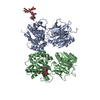+ Open data
Open data
- Basic information
Basic information
| Entry | Database: PDB / ID: 6wiv | |||||||||||||||||||||
|---|---|---|---|---|---|---|---|---|---|---|---|---|---|---|---|---|---|---|---|---|---|---|
| Title | Structure of human GABA(B) receptor in an inactive state | |||||||||||||||||||||
 Components Components | (Gamma-aminobutyric acid type B receptor subunit ...) x 2 | |||||||||||||||||||||
 Keywords Keywords | MEMBRANE PROTEIN / G protein coupled receptor (GPCR) / GABA / GABA(B) receptor / Class C GPCR / Phospholipids / Inhibitory neurotransmission. | |||||||||||||||||||||
| Function / homology |  Function and homology information Function and homology informationG protein-coupled neurotransmitter receptor activity involved in regulation of postsynaptic membrane potential / GABA B receptor activation / G protein-coupled neurotransmitter receptor activity involved in regulation of presynaptic membrane potential / G protein-coupled GABA receptor complex / negative regulation of gamma-aminobutyric acid secretion / neuron-glial cell signaling / G protein-coupled GABA receptor activity / G protein-coupled receptor heterodimeric complex / negative regulation of epinephrine secretion / negative regulation of dopamine secretion ...G protein-coupled neurotransmitter receptor activity involved in regulation of postsynaptic membrane potential / GABA B receptor activation / G protein-coupled neurotransmitter receptor activity involved in regulation of presynaptic membrane potential / G protein-coupled GABA receptor complex / negative regulation of gamma-aminobutyric acid secretion / neuron-glial cell signaling / G protein-coupled GABA receptor activity / G protein-coupled receptor heterodimeric complex / negative regulation of epinephrine secretion / negative regulation of dopamine secretion / positive regulation of growth hormone secretion / extracellular matrix protein binding / GABA receptor complex / negative regulation of adenylate cyclase activity / Class C/3 (Metabotropic glutamate/pheromone receptors) / synaptic transmission, GABAergic / gamma-aminobutyric acid signaling pathway / positive regulation of glutamate secretion / negative regulation of synaptic transmission / axolemma / GABA-ergic synapse / adenylate cyclase-inhibiting G protein-coupled receptor signaling pathway / dendritic shaft / mitochondrial membrane / response to nicotine / Schaffer collateral - CA1 synapse / Activation of G protein gated Potassium channels / Inhibition of voltage gated Ca2+ channels via Gbeta/gamma subunits / osteoblast differentiation / transmembrane signaling receptor activity / synaptic vesicle / presynaptic membrane / G alpha (i) signalling events / chemical synaptic transmission / postsynaptic membrane / response to ethanol / dendritic spine / neuron projection / G protein-coupled receptor signaling pathway / protein heterodimerization activity / negative regulation of cell population proliferation / neuronal cell body / glutamatergic synapse / endoplasmic reticulum membrane / extracellular space / plasma membrane / cytoplasm Similarity search - Function | |||||||||||||||||||||
| Biological species |  Homo sapiens (human) Homo sapiens (human) | |||||||||||||||||||||
| Method | ELECTRON MICROSCOPY / single particle reconstruction / cryo EM / Resolution: 3.3 Å | |||||||||||||||||||||
 Authors Authors | Park, J. / Fu, Z. / Frangaj, A. / Liu, J. / Mosyak, L. / Shen, T. / Slavkovich, V.N. / Ray, K.M. / Taura, J. / Cao, B. ...Park, J. / Fu, Z. / Frangaj, A. / Liu, J. / Mosyak, L. / Shen, T. / Slavkovich, V.N. / Ray, K.M. / Taura, J. / Cao, B. / Geng, Y. / Zuo, H. / Kou, Y. / Grassucci, R. / Chen, S. / Liu, Z. / Lin, X. / Williams, J.P. / Rice, W.J. / Eng, E.T. / Huang, R.K. / Soni, R.K. / Kloss, B. / Yu, Z. / Javitch, J.A. / Hendrickson, W.A. / Slesinger, P.A. / Quick, M. / Graziano, J. / Yu, H. / Fiehn, O. / Clarke, O.B. / Frank, J. / Fan, Q.R. | |||||||||||||||||||||
| Funding support |  United States, 6items United States, 6items
| |||||||||||||||||||||
 Citation Citation |  Journal: Nature / Year: 2020 Journal: Nature / Year: 2020Title: Structure of human GABA receptor in an inactive state. Authors: Jinseo Park / Ziao Fu / Aurel Frangaj / Jonathan Liu / Lidia Mosyak / Tong Shen / Vesna N Slavkovich / Kimberly M Ray / Jaume Taura / Baohua Cao / Yong Geng / Hao Zuo / Yongjun Kou / Robert ...Authors: Jinseo Park / Ziao Fu / Aurel Frangaj / Jonathan Liu / Lidia Mosyak / Tong Shen / Vesna N Slavkovich / Kimberly M Ray / Jaume Taura / Baohua Cao / Yong Geng / Hao Zuo / Yongjun Kou / Robert Grassucci / Shaoxia Chen / Zheng Liu / Xin Lin / Justin P Williams / William J Rice / Edward T Eng / Rick K Huang / Rajesh K Soni / Brian Kloss / Zhiheng Yu / Jonathan A Javitch / Wayne A Hendrickson / Paul A Slesinger / Matthias Quick / Joseph Graziano / Hongtao Yu / Oliver Fiehn / Oliver B Clarke / Joachim Frank / Qing R Fan /    Abstract: The human GABA receptor-a member of the class C family of G-protein-coupled receptors (GPCRs)-mediates inhibitory neurotransmission and has been implicated in epilepsy, pain and addiction. A unique ...The human GABA receptor-a member of the class C family of G-protein-coupled receptors (GPCRs)-mediates inhibitory neurotransmission and has been implicated in epilepsy, pain and addiction. A unique GPCR that is known to require heterodimerization for function, the GABA receptor has two subunits, GABA and GABA, that are structurally homologous but perform distinct and complementary functions. GABA recognizes orthosteric ligands, while GABA couples with G proteins. Each subunit is characterized by an extracellular Venus flytrap (VFT) module, a descending peptide linker, a seven-helix transmembrane domain and a cytoplasmic tail. Although the VFT heterodimer structure has been resolved, the structure of the full-length receptor and its transmembrane signalling mechanism remain unknown. Here we present a near full-length structure of the GABA receptor, captured in an inactive state by cryo-electron microscopy. Our structure reveals several ligands that preassociate with the receptor, including two large endogenous phospholipids that are embedded within the transmembrane domains to maintain receptor integrity and modulate receptor function. We also identify a previously unknown heterodimer interface between transmembrane helices 3 and 5 of both subunits, which serves as a signature of the inactive conformation. A unique 'intersubunit latch' within this transmembrane interface maintains the inactive state, and its disruption leads to constitutive receptor activity. | |||||||||||||||||||||
| History |
|
- Structure visualization
Structure visualization
| Movie |
 Movie viewer Movie viewer |
|---|---|
| Structure viewer | Molecule:  Molmil Molmil Jmol/JSmol Jmol/JSmol |
- Downloads & links
Downloads & links
- Download
Download
| PDBx/mmCIF format |  6wiv.cif.gz 6wiv.cif.gz | 257.6 KB | Display |  PDBx/mmCIF format PDBx/mmCIF format |
|---|---|---|---|---|
| PDB format |  pdb6wiv.ent.gz pdb6wiv.ent.gz | 211.7 KB | Display |  PDB format PDB format |
| PDBx/mmJSON format |  6wiv.json.gz 6wiv.json.gz | Tree view |  PDBx/mmJSON format PDBx/mmJSON format | |
| Others |  Other downloads Other downloads |
-Validation report
| Arichive directory |  https://data.pdbj.org/pub/pdb/validation_reports/wi/6wiv https://data.pdbj.org/pub/pdb/validation_reports/wi/6wiv ftp://data.pdbj.org/pub/pdb/validation_reports/wi/6wiv ftp://data.pdbj.org/pub/pdb/validation_reports/wi/6wiv | HTTPS FTP |
|---|
-Related structure data
| Related structure data |  21685MC M: map data used to model this data C: citing same article ( |
|---|---|
| Similar structure data | |
| EM raw data |  EMPIAR-10410 (Title: Structure of human GABA(B) receptor in an inactive state EMPIAR-10410 (Title: Structure of human GABA(B) receptor in an inactive stateData size: 854.1 Data #1: Unaligned multi-frame micrographs of GABA(B) receptor in the inactive state [micrographs - multiframe]) |
- Links
Links
- Assembly
Assembly
| Deposited unit | 
|
|---|---|
| 1 |
|
- Components
Components
-Gamma-aminobutyric acid type B receptor subunit ... , 2 types, 2 molecules AB
| #1: Protein | Mass: 91585.867 Da / Num. of mol.: 1 Source method: isolated from a genetically manipulated source Source: (gene. exp.)  Homo sapiens (human) / Gene: GABBR1, GPRC3A / Cell line (production host): HEK293 GnTl- / Production host: Homo sapiens (human) / Gene: GABBR1, GPRC3A / Cell line (production host): HEK293 GnTl- / Production host:  Homo sapiens (human) / References: UniProt: Q9UBS5 Homo sapiens (human) / References: UniProt: Q9UBS5 |
|---|---|
| #2: Protein | Mass: 93278.781 Da / Num. of mol.: 1 Source method: isolated from a genetically manipulated source Source: (gene. exp.)  Homo sapiens (human) / Gene: GABBR2, GPR51, GPRC3B / Cell line (production host): HEK293 GnTl- / Production host: Homo sapiens (human) / Gene: GABBR2, GPR51, GPRC3B / Cell line (production host): HEK293 GnTl- / Production host:  Homo sapiens (human) / References: UniProt: O75899 Homo sapiens (human) / References: UniProt: O75899 |
-Sugars , 1 types, 4 molecules 
| #3: Sugar | ChemComp-NAG / |
|---|
-Non-polymers , 4 types, 13 molecules 


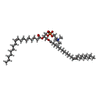



| #4: Chemical | ChemComp-CA / | ||
|---|---|---|---|
| #5: Chemical | ChemComp-U3G / ( | ||
| #6: Chemical | ChemComp-CLR / #7: Chemical | ChemComp-U3D / [( | |
-Details
| Has ligand of interest | Y |
|---|
-Experimental details
-Experiment
| Experiment | Method: ELECTRON MICROSCOPY |
|---|---|
| EM experiment | Aggregation state: PARTICLE / 3D reconstruction method: single particle reconstruction |
- Sample preparation
Sample preparation
| Component | Name: Heterodimer human GABA(B) receptor composed of GABA(B1b) and GABA(B2) subunits. Type: COMPLEX / Entity ID: #1-#2 / Source: RECOMBINANT | |||||||||||||||||||||||||
|---|---|---|---|---|---|---|---|---|---|---|---|---|---|---|---|---|---|---|---|---|---|---|---|---|---|---|
| Molecular weight | Value: 0.193 MDa / Experimental value: YES | |||||||||||||||||||||||||
| Source (natural) | Organism:  Homo sapiens (human) Homo sapiens (human) | |||||||||||||||||||||||||
| Source (recombinant) | Organism:  Homo sapiens (human) / Cell: HEK 293 GnTI- / Plasmid: modified bacMam Homo sapiens (human) / Cell: HEK 293 GnTI- / Plasmid: modified bacMam | |||||||||||||||||||||||||
| Buffer solution | pH: 7.5 Details: Solutions were made fresh from concentrated and filtered to avoid microbial contamination. | |||||||||||||||||||||||||
| Buffer component |
| |||||||||||||||||||||||||
| Specimen | Conc.: 0.3 mg/ml / Embedding applied: NO / Shadowing applied: NO / Staining applied: NO / Vitrification applied: YES / Details: This sample was monodisperse | |||||||||||||||||||||||||
| Specimen support | Grid material: GOLD / Grid mesh size: 300 divisions/in. / Grid type: Quantifoil R0.6/1 | |||||||||||||||||||||||||
| Vitrification | Instrument: FEI VITROBOT MARK IV / Cryogen name: ETHANE-PROPANE / Humidity: 100 % / Chamber temperature: 277 K / Details: blot for 4 seconds before plunging |
- Electron microscopy imaging
Electron microscopy imaging
| Experimental equipment |  Model: Titan Krios / Image courtesy: FEI Company |
|---|---|
| Microscopy | Model: FEI TITAN KRIOS / Details: Preliminary grid screening was performed manually. |
| Electron gun | Electron source:  FIELD EMISSION GUN / Accelerating voltage: 300 kV / Illumination mode: FLOOD BEAM FIELD EMISSION GUN / Accelerating voltage: 300 kV / Illumination mode: FLOOD BEAM |
| Electron lens | Mode: BRIGHT FIELD / Nominal magnification: 130000 X / Nominal defocus max: -2000 nm / Nominal defocus min: -500 nm / Cs: 2.7 mm / C2 aperture diameter: 70 µm / Alignment procedure: COMA FREE |
| Specimen holder | Cryogen: NITROGEN / Specimen holder model: FEI TITAN KRIOS AUTOGRID HOLDER / Temperature (max): 100 K |
| Image recording | Average exposure time: 12 sec. / Electron dose: 85 e/Å2 / Detector mode: COUNTING / Film or detector model: GATAN K2 SUMMIT (4k x 4k) / Num. of grids imaged: 1 / Num. of real images: 3435 |
| EM imaging optics | Energyfilter slit width: 20 eV |
| Image scans | Movie frames/image: 60 / Used frames/image: 1-60 |
- Processing
Processing
| EM software |
| |||||||||||||||||||||||||||||||||||||||||||||
|---|---|---|---|---|---|---|---|---|---|---|---|---|---|---|---|---|---|---|---|---|---|---|---|---|---|---|---|---|---|---|---|---|---|---|---|---|---|---|---|---|---|---|---|---|---|---|
| CTF correction | Type: PHASE FLIPPING AND AMPLITUDE CORRECTION | |||||||||||||||||||||||||||||||||||||||||||||
| Particle selection | Num. of particles selected: 1048241 | |||||||||||||||||||||||||||||||||||||||||||||
| Symmetry | Point symmetry: C1 (asymmetric) | |||||||||||||||||||||||||||||||||||||||||||||
| 3D reconstruction | Resolution: 3.3 Å / Resolution method: FSC 0.143 CUT-OFF / Num. of particles: 233737 / Num. of class averages: 1 / Symmetry type: POINT | |||||||||||||||||||||||||||||||||||||||||||||
| Atomic model building | Protocol: FLEXIBLE FIT / Space: REAL | |||||||||||||||||||||||||||||||||||||||||||||
| Atomic model building |
| |||||||||||||||||||||||||||||||||||||||||||||
| Refinement | Stereochemistry target values: GeoStd + Monomer Library + CDL v1.2 | |||||||||||||||||||||||||||||||||||||||||||||
| Displacement parameters | Biso mean: 68.95 Å2 | |||||||||||||||||||||||||||||||||||||||||||||
| Refine LS restraints |
|
 Movie
Movie Controller
Controller



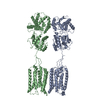
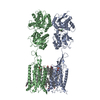




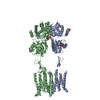

 PDBj
PDBj













